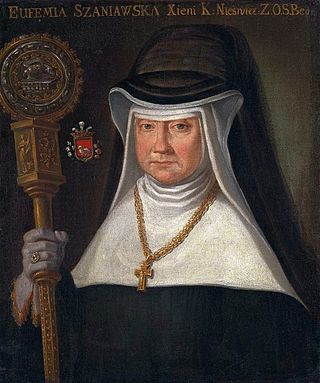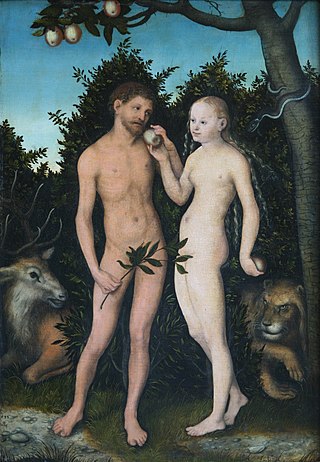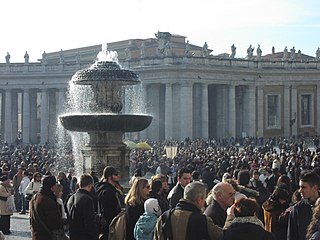
An abbess is the female superior of a community of nuns in an abbey.

The Tridentine Mass, also known as the Traditional Latin Mass or the Traditional Rite, is the liturgy in the Roman Missal of the Catholic Church codified in 1570 and published thereafter with amendments up to 1962. Celebrated almost exclusively in Ecclesiastical Latin, it was the most widely used Eucharistic liturgy in the world from its issuance in 1570 until the introduction of the Mass of Paul VI.
Subdeacon is a minor order of ministry for men in various branches of Christianity. The subdeacon has a specific liturgical role and is placed below the deacon and above the acolyte in the order of precedence.

An acolyte is an assistant or follower assisting the celebrant in a religious service or procession. In many Christian denominations, an acolyte is anyone performing ceremonial duties such as lighting altar candles. In others, the term is used for one who has been inducted into a particular liturgical ministry, even when not performing those duties.

An altar server is a lay assistant to a member of the clergy during a Christian liturgy. An altar server attends to supporting tasks at the altar such as fetching and carrying, ringing the altar bell, helping bring up the gifts, and bringing up the liturgical books, among other things. If young, the server is commonly called an altar boy or altar girl. In some Christian denominations, altar servers are known as acolytes.
In Christianity, minor orders are ranks of church ministry. In the Catholic Church, the predominating Latin Church formerly distinguished between the major orders —priest, deacon and subdeacon—and four minor orders—acolyte, exorcist, lector, and porter. In 1972, the Vatican re-titled the minor orders as "ministries", with those of lector and acolyte being kept throughout the Latin Church. In the Eastern Orthodox Church, the three minor orders in use are those of subdeacon, reader and chanter.

In some Christian denominations, a reader or lector is the person responsible for reading aloud excerpts of scripture at a liturgy. In early Christian times the reader was of particular value due to the rarity of literacy.
The hierarchy of the Catholic Church consists of its bishops, priests, and deacons. In the ecclesiological sense of the term, "hierarchy" strictly means the "holy ordering" of the church, the Body of Christ, so to respect the diversity of gifts and ministries necessary for genuine unity.
Christine Mayr-Lumetzberger is a teacher and former Benedictine nun who was excommunicated from the Roman Catholic Church when she and six others were ordained as priests by an Independent Catholic bishop in 2002. She was ordained a bishop in 2003 along with Gisela Forster; reportedly, the ordination was performed by Roman Catholic bishops whose identity remains a secret.

The Mass is the central liturgical service of the Eucharist in the Catholic Church, in which bread and wine are consecrated and become the body and blood of Christ. As defined by the Church at the Council of Trent, in the Mass "the same Christ who offered himself once in a bloody manner on the altar of the cross, is present and offered in an unbloody manner". The Church describes the Mass as the "source and summit of the Christian life", and teaches that the Mass is a sacrifice, in which the sacramental bread and wine, through consecration by an ordained priest, become the sacrificial body, blood, soul, and divinity of Christ as the sacrifice on Calvary made truly present once again on the altar. The Catholic Church permits only baptised members in the state of grace to receive Christ in the Eucharist.

The sacrament of holy orders in the Catholic Church includes three orders: bishops, priests, and deacons, in decreasing order of rank, collectively comprising the clergy. In the phrase "holy orders", the word "holy" means "set apart for a sacred purpose". The word "order" designates an established civil body or corporation with a hierarchy, and ordination means legal incorporation into an order. In context, therefore, a group with a hierarchical structure that is set apart for ministry in the Church.

Joseph Fessio is an American Jesuit priest, as well as the founder and editor of Ignatius Press. After studying with Joseph Ratzinger, he founded the St. Ignatius Institute at the University of San Francisco, one of the first Catholic Great Books programs in the United States, then served as the founding provost of Ave Maria University. He hosts the weekly podcast Father Fessio in Five.

A Catholic funeral is carried out in accordance with the prescribed rites of the Catholic Church. Such funerals are referred to in Catholic canon law as "ecclesiastical funerals" and are dealt with in canons 1176–1185 of the 1983 Code of Canon Law, and in canons 874–879 of the Code of Canons of the Eastern Churches. In Catholic funerals, the Church "seeks spiritual support for the deceased, honors their bodies, and at the same time brings the solace of hope to the living." The Second Vatican Council in its Constitution on the Liturgy decreed: "The rite for the burial of the dead should express more clearly the paschal character of Christian death, and should correspond more closely to the circumstances and traditions found in various regions."
The Knights of the Altar is the name of a number of national organizations of serving and former altar boys in the Roman Catholic church, including the Philippines, Ireland the United States, and Canada. It traces itself back to an organization founded by Saint John Bosco.

In the liturgical traditions of the Catholic Church, the term ordination refers to the means by which a person is included in one of the holy orders of bishops, priests or deacons. The teaching of the Catholic Church on ordination, as expressed in the 1983 Code of Canon Law, the Catechism of the Catholic Church, and the apostolic letter Ordinatio sacerdotalis, is that only a Catholic male validly receives ordination, and "that the Church has no authority whatsoever to confer priestly ordination on women and that this judgment is to be definitively held by all the Church's faithful." In other words, the male priesthood is not considered by the church a matter of policy but an unalterable requirement of God. As with priests and bishops, the church ordains only men as deacons.

Women play significant roles in the life of the Catholic Church, although excluded from the Catholic hierarchy of bishops, priests, and deacons. In the history of the Catholic Church, the church often influenced social attitudes toward women. Influential Catholic women have included theologians, abbesses, monarchs, missionaries, mystics, martyrs, scientists, nurses, hospital administrators, educationalists, religious sisters, Doctors of the Church, and canonised saints. Women constitute the majority of members of consecrated life in the Catholic Church: in 2010, there were around 721,935 professed women religious. Motherhood and family are given an exalted status in Catholicism, with The Blessed Virgin Mary holding a special place of veneration.
This is a glossary of terms used within the Catholic Church. Some terms used in everyday English have a different meaning in the context of the Catholic faith, including brother, confession, confirmation, exemption, faithful, father, ordinary, religious, sister, venerable, and vow.
In the Roman Catholic Church, the term minister is used with various meanings. Most commonly, the word refers to a person, either lay or ordained, who is commissioned to perform some act on behalf of the Catholic Church. It is not a particular office or rank of clergy, as is the case in some other Christian organisations; rather, minister may be used as a collective term for vocational or professional pastoral leaders including clergy and non-clergy. It is also used in reference to the canonical and liturgical administration of sacraments, as part of some offices, and with reference to the exercise of the lay apostolate.

Catholic laity are the ordinary members of the Catholic Church who are neither clergy nor recipients of Holy Orders or vowed to life in a religious order or congregation. Their mission, according to the Second Vatican Council, is to "sanctify the world".
Spiritus Domini is an apostolic letter in the form of a motu proprio by Pope Francis signed on 10 January 2021 and released the next day. It changed the 1983 Code of Canon Law to allow women to be admitted to the instituted ministries of acolyte and lector (reader), which had until then been exclusively available to men.

















